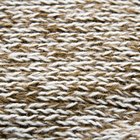Whether taking a walk in the park on a brisk autumn day or going for a morning snowboarding run down the slopes, you want a scarf that keeps you warm and enhances your outfit while you take on the day's activities. Choose an acrylic scarf if you want something inexpensive and sensitive to your skin; while wool is a good choice if you're looking for a scarf that's naturally soft and water resistant. Both materials perform well as clothing accessories for cooler weather.
Acrylic Fibers
An acrylic scarf is made from acrylic fibers, a synthetic material. It is a man-made textile that's lightweight, inexpensive and does not usually require special care instructions. It does not fade easily and is wrinkle- and stain-resistant. Although acrylic is not as soft or as breathable as natural fibers, it is an effective alternative for people with sensitive skin and/or who have allergic reactions to wool. Acrylic scarves hold their shape and can be wrapped around the neck loosely, clasped in a loop over your shoulders, or tied and tucked into your coat.
Wool Properties
Wool is a natural fiber that is derived from animal fleece. Its properties make it a fine material for scarves and other cool-weather clothing. Wool is water-resistant and wicks away moisture. Wool fiber can hold up to 30 percent of its weight when exposed to moisture without becoming damp. It also keeps bodies dry by absorbing moisture (like perspiration) and draws it away. Wool's hollow fibers and unique ability to create air pockets over the skin make this material breathable and a great insulator.
Types of Wool
Wool can be obtained from animals such as goats, alpacas, camels and rabbits -- but the most common variety is sheep's wool. Within the sheep category, wool is made into a variety of types such as merino and lambswool. The former is lightweight, has a great shine and does not feel as itchy as other (coarse) wools. Merino wool is great for scarves as it can easily be dyed a variety of colors to match your ensemble. Lambswool is an extremely soft wool, obtained during the first shearing of a young sheep. A scarf made from lambswool will feel silky smooth on the skin.
Scarf Size, Color and Designs
Once you've decided on wool or acrylic (or even a blend of the two fibers), selecting the perfect scarf will depend on size, color and/or patterns. Try on different scarves and pay attention to length and width. A scarf that's too short will be difficult to tie. A scarf that's not very wide won't offer the protection you desire around your neck.
Scarves look best when they complement an outfit, but should not match it completely. For example, a red scarf paired with a coat sporting the exact red shade may make you look like one large color block. For something more dynamic, choose a wool or acrylic scarf that features a pattern. Houndstooth, plaid and striped patterns are just some of many designs available.
Related Articles

How to Wash an Acrylic & Viscose Scarf

What Can I Do to Prevent a Wool Coat ...

How to Protect Cashmere Scarves From ...

How to Clean Pashmina Scarves

How to Make a Wool Scarf Less Scratchy

Can a Wool Coat Be Worn in the Rain?

Acrylic Vs. Cotton Socks

How to Make a Sweater Softer

How to Wash a Pashmina Scarf

Linen vs. Wool Blazer

Things to Do With an Itchy Scarf

How to Stretch Wool After Shrinking It

How to Take Care of a Wet & Wavy Weave

Properties of Cashmere Yarn

Cashmere Allergies

Styling a Strapless Dress for the Winter

How to Make a Pashmina Jacket

Microfiber vs. Cotton Clothes

Wool Vs. Polyester Suits

How to Clean an Aran Hand Knitted ...
References
Writer Bio
Diane Bautista has more than seven years of professional experience writing for a variety of industries including fashion retail, communications technology and nonprofit. She currently works as an advertising copywriter and holds a B.A. in English from Washington State University.